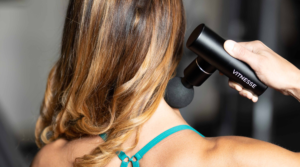Massage Gun Benefits – How Effective Are They?


Athletes at all levels around the world are constantly looking for an edge over the competition and physical therapists are always searching for new tools to help their patients.
So, are massage guns effective or not? In recent times, this device has made a big splash in the health community and the hype needs to be dispelled to look at the actual benefits of using this tool as part of your health routine.
THE BENEFITS OF PERCUSSION MASSAGE DEVICES
POST WORKOUT RECOVERY
Firstly, massage guns, also known as percussion massage devices, are often advertised as a one stop solution to a faster recovery, promising immense reductions in muscle soreness and muscle recovery times. Studies by several groups of researchers have found supporting evidence for many of these claims. A recent study by Lu et al., compiled and analysed results from several papers which found that subjective pain and levels of the muscle damage marker Creatine Kinase showed a significant decrease at time intervals of 24, 48 and 72 hours post workout.
On another note, a study by Fuller et al. compared the use of manual massage and percussion massage devices after 100 repetitions of eccentric muscle contractions and the results favoured neither form of therapy. This essentially means that a percussion massage can be as effective as having a massage, but the knowledge and different techniques are missing, of course.
DECREASES PAIN OF FIBROMYALGIA
Secondly, a blind study performed by Kraft K, et al., on patients suffering from chronic pain due to fibromyalgia found that “deep oscillation massage (DOS)” noticeably decreased pain and improved quality of life for most of the test subjects who had a low intensity, low frequency treatment applied to them. Although the results were inconclusive in determining its potential clinical use, the Visual analog scale (VAS) results speak for themselves towards the subjective benefits that were experienced.
“The results suggest that deep oscillation massage is safe and well tolerable in patients with FMS. It even might be an efficacious single modality treatment, which should be confirmed in a controlled study.” – Karin Kraft
IMPROVES LYMPHATIC AND CARDIOVASCULAR SYSTEM
A percussion massage device can penetrate tissue better and deeper than the hands of a human, allowing the lymphatic system to drain lactic acid and other waste more efficiently. The cardiovascular system experiences similar effects which aid in delivering fresh nutrients and oxygen to the strained muscles. These effects combined make for a very efficient and speedy recovery process.
INCREASES RANGE OF MOVEMENT
The percussive tapping allows your muscles to be more flexible and relaxed, which helps to improve posture and athletic performance in many areas. When you are training intensely, injuries, small and major, may occur and they are healed by the fascia, which is the name of the connective tissue that holds your internal organs and tissues together. When this healing occurs, the fascia tightens, which creates a cushion for healing and scar tissue is formed as part of the process. When massaged the fascia is assisted in its work of healing the body and scar tissue is softened over time which can help in avoiding lasting inflexibility after an injury.
REDUCES STRESS AND IMPROVES QUALITY OF SLEEP
Some minor benefits include; aid in breaking down of cellulites and some evidence of reduced stress and improved sleeping patterns.
CONCLUSION
To summarise, despite needing further study to quantify its clinical benefits, percussion massage has proven effective throughout several clinical trials and has shown to be a strong contender in both the athletic and physiotherapeutic industry. It may not be a miracle machine, but it can certainly decrease post workout pain and help those who suffer from chronic pain to lead a tolerable life.

Given the massage guns’ ease of use and portability, there are a few reasons to give it a try and experience these benefits for yourself. Check out the ‘Vitnesse Mini Massage Gun’ and see for yourself (or should I say ‘feel’:)


